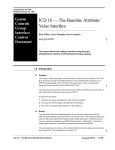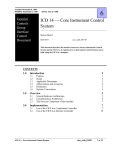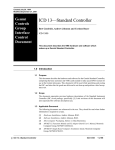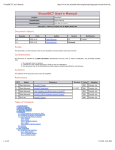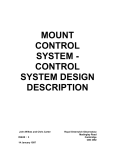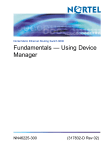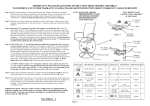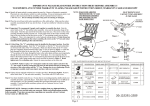Download ICD 4 — Logging Information
Transcript
Created:July 19, 1994
Modified:December 18, 1996
Gemini
ICD 4 — Logging Information
Data
Handling
System
Report
Norman Hill, Severin Gaudet
dhs_pdr_icd4/11
This document defines the interfaces in the Gemini System which
involve the transfer of history logging information between principal
systems and the DHS.
1.0
Introduction
This document defines the interfaces in the Gemini System which involve the transfer of history
logging information between principal systems and the DHS.
1.1
Purpose
The Gemini Software Design Description [1] contains a design for the major Gemini systems. An
overview describing all the interfaces between the Gemini systems is given in document [3] (See
the list of references on page 2 for more background material).
This document (ICD 4 — Logging Information) specifies those interfaces in the Gemini system
which involve the transfer of logging information from Gemini principal systems to the DHS.
1.2
1.2.1
Scope
Data flows covered
The document covers only History logging requests and data sent from the TCS, ICS, OCS or
DHS to the DHS Logging System during the normal course of observing. These are messages
generated asynchronously by the various systems and sent for logging.
This document does not cover:
1. The handling of logging data after it is received by the DHS.
2. File headers read from the Data Store.
3. Engineering logs generated by the day crew or by engineers while testing or commissioning
an instrument.
4. The routine logging of EPICS system status using the EPICS archiver.
ICD 4 — Logging Information
icd4-1
Introduction
The first of these are covered in the DHS Software Design Description, and the second is covered
in document [8] (“ICD 3 — Bulk Data Transfer”). The last two are covered in the EPICS archiving reference manual [11].
1.2.2
Types of logging covered
The Data Handling System is responsible for three basic types of logging:
1. A database recording the use made of the system for system administrators.
2. The recording of a history of the commands executed, the errors reported on the system and a
history of the status of the system.
Only the third of these types of logging is covered in this document. The first two are internal to
the DHS.
1.3
Applicable Documents
The following documents should also be consulted:
[1]
[2]
[3]
[4]
[5]
[6]
[7]
[8]
[9]
[10]
[11]
[12]
[13]
[14]
1.4
icd4-2
Gemini Software Design Description, SPE-C-G0037, Gemini 8m Telescopes Project
Gemini Software Programming Standards, SPE-C-G0009/02, Peregrine M.McGehee,
Steve Wampler, Gemini 8m Telescopes Project
Gemini System Interfaces, GSCG.grp.005, Gemini 8m Telescopes Project
ICD 1a — The System Command Interface, GSCG.KKG.009/009, Kim Gillies, Gemini
8m Telescopes Project
ICD 1b - The Baseline Attribute/Value Interface, GSCG.grp.024, Kim Gillies, Steve
Wampler, Bret Goodrich, Gemini 8m Telescopes Project
ICD 1c — Baseline DHS interface
erin Gaudet and
Dayle Kotturi, HIA
ICD 2 — Systems Status and Alarm Interface, Version GSCG.grp.013-ICD2/005, Kim
Gillies, Gemini 8m Telescopes Project
ICD 3 — Bulk Data Transfer
erin Gaudet, HIA
ICD 8 — Non-Conforming ICS Interfaces, GSCG.grp.012, Gemini 8m Telescopes Project
DHS Project Glossary, dhs_project_g/02, Norman Hill, Dayle K
erin Gaudet, HIA
EPICS Archiving Reference Manual (DRAFT), Roger Cole, Los Alamos National Laboratory. [N.B. This document is in preparation. The Gemini project has a draft copy. Contact
the author for up to date information.]
EPICS R3.12 Channel Access Reference Manual, Jeffrey O. Hill, Controls and Automation Group, Los Alamos National Laboratory
EPICS IOC Record Reference Manual, Janet B. Anderson, Martin R. Kraimer, October,
1992, Los Alamos National Laboratory
CAPFAST Electronic Circuit Design CAE User’s Manual, Phase Three Logic inc., Beaverton, Oregon
Abbreviations and Acronyms
AAO
Anglo-Australian Observatory.
AR
EPICS archiving tool.
ICD 4 — Logging Information
Introduction
1.5
ARR
EPICS archive retrieval tool.
ASCII
American Standard Code for Information Interchange.
BNF
Backus Naur Form.
CA
EPICS Channel Access.
DITS
Distributed Instrumentation Tasking System.
DHS
Data Handling System.
DRAMA
Distributed Real-time AAO Monitor for Astronomy.
EPICS
Experimental Physics and Industrial Control System.
GCS
Gemini Control System.
GSCG
Gemini Software and Controls Group.
ICD
Interface Control Document.
ICS
Instrument Control System.
IGPO
International Gemini Project Office.
LAN
Local Area Network.
N/A
Not Applicable (indicates sections of the Gemini ICS template
which do not apply for this kind of interface).
OCS
Observatory Control System.
PDF
Parameter description file.
SAD
Status/Alarm Database.
SDD
Software Design Description.
SIR
Status Information Record.
TCP/IP
Transmission Control Protocol/Internet Protocol.
TCS
Telescope Control System.
UDP/IP
User Datagram Protocol/Internet Protocol.
VME
A real-time system obeying the ANSI/IEEE 1014-1987 Versatile
Backplane Bus standard.
Glossary
Backus Naur Form — A method of defining the relationship between data objects using a series
of short-hand symbols to represent combination, choices and repetition. The symbols
are
ICD 4 — Logging Information
=
“consists of”
+
“and” (sequence)
[|]
“or” (selection)
{}
“repeating” (iteration)
()
“optional components”
@
“identifier, key attribute”
icd4-3
Introduction
-ref
“reference to (key of) another data object”
;
“end of sentence”
See Section 1.6.3 on page 4 for some examples.
Control LAN — Local Area Network in the Gemini system devoted to the movement of commands, alarms, and status information.
DHS Logging system — The part of the DHS dedicated to monitoring the EPICS SIR records
used by other systems for history logging.
EPICS database client — A system which accesses the EPICS database by reading or writing
records, or registering an interest in updates to records.
Logging device — A Gemini principal system which has information to be logged by the DHS
logging system. A logging device must be an EPICS database client.
Principal system1 — At the highest level in the GCS software decomposition, the software system is divided into four kinds of software systems called principal systems. The four
types are called: the Data Handling System, the Observatory Control System, the Telescope Control System, and the Instrument Control System. There may be up to four
concurrently executing Instrument Control Systems.
Subsystem — A software system making up a well-defined unit within one “Principal system”.
Unix — A standard host-level operating system. The Gemini baseline for “Unix” is “Solaris”
marketed by Sun Microsystems.
VxWorks — A real-time operating system for VME hardware marketed by Wind River Systems.
See [10] for more definitions.
1.6
1.6.1
Stylistic Conventions
References to other documents.
References to other documents are given using a number in square brackets, for example [1]. The
exact references are given in Section 1.3 on page 2.
1.6.2
References to the Gemini systems
The term “logging system” refers to that part of the Data Handling System which is responsible
for handling the archiver and history logging events described in this document.
1.6.3
System commands and attributes
System commands and attribute names are given in upper case.
The lists of attributes required by a command, and any list of components making up a data structure, are given in “Backus Naur Form” (BNF). For example;
Message = Command + Parameters
means that “Message” consists of “Command” followed by “Parameters”.
Parameters = Parameter1 + {Parameter2} + (Parameter3)
1. Not to be confused with the term “Major System”, which is used for describing various kinds of
work package.
icd4-4
ICD 4 — Logging Information
Overview
means that “Parameters” consists of “Parameter1”, followed by an iterating sequence of
“Parameter2”s, which may then optionally be followed by “Parameter3”.
Parameter1 = [‘left’ | ‘right’ | ‘up’ | ‘down’]
means that “Parameter1” consists of a choice of one of the strings shown. Section 1.5, “Glossary,” on page 3 contains more information.
2.0
Overview
The Gemini Control System (GCS) is made up of principal software systems: the Telescope Control System (TCS), the Data Handling System (DHS), the Observatory Control System (OCS),
and one or more Instrument Control Systems (ICS). In addition, these principal systems may
contain low-level subsystems which are responsible for a particular area (such as the Acquisition
and Guidance subsystem). The Software Design Description, [1], describes the Gemini Control
System. Document [3] shows which data flows in the Gemini Control System are covered by this
ICD.
Every system and subsystem in the GCS must be able to log events and messages, so that a history of the tasks carried out by the various systems can be mapped. The DHS logging system is
the part of the DHS dedicated to receiving and storing the history log data sent by other systems.
This ICD covers only the logging of history information from the various systems describing the
events which are happening within them.This document does not constrain how the history log
data will be stored.
2.1
System Hardware Architecture
The overall layout of the computer hardware and communication equipment is shown in Figure 1
which is taken from [3] and modified to reflect recent design decisions.
2.1.1
The Observatory Control System (OCS)
The OCS is assumed to be based on a Unix workstation (baselined as a Sun Sparcstation running
Solaris 2.X).
No other OCS architectures are currently supported.
2.1.2
The Telescope Control System (TCS)
The TCS and its subsystems are assumed to be VME-based running VxWorks and EPICS.
No other TCS architectures are currently supported.
2.1.3
The Instrument Control Systems (ICS)
A “conforming” ICS is VME-based running VxWorks and EPICS.
A “non-conforming” ICS is based on some other architecture without access to EPICS or
VxWorks.
This document assumes the ICS architecture is conforming. See [9] for a description of the interface to a non-conforming ICS.
ICD 4 — Logging Information
icd4-5
Overview
FIGURE 1.
The System Hardware Architecture
2.1.4
The Data Handling System (DHS)
The DHS is assumed to be based on a Unix workstation (baselined as a Sun Sparcstation running
Solaris 2.X).
No other DHS architectures are currently supported.
2.2
Communication Architecture
The TCS, ICS, OCS and DHS communicate with the DHS logging system using an FDDI or
Ethernet Local Area Network (LAN). The LAN used is the one referred to as the “Control LAN”
in other Gemini documents.
2.2.1
Context Diagram
Figure 2 on page 7 shows a context diagram as seen by the logging interface. The Gemini systems appear to the interface as entities in its outside world. The diagram may be compared to the
“Gemini Control System” data flow diagrams contained in [1].
icd4-6
ICD 4 — Logging Information
Overview
FIGURE 2.
Context Diagram
Instrument
Control
System
Telescope
Control
System
TCS Logging
Requests
ICS Logging
Requests
ICD 4
Logging
Information
History Logging
Requests
Observation
header
data
OCS Logging
Requests
DHS Logging
Requests
Observatory
Control
System
DHS
Logging
System
Combined
Logging
data
Permanent
Store
Data
Handling
System
The “DHS logging system” in the data flow diagram is part of the DHS.
2.2.2
Events and Responses
The events which may happen on the logging interface, and the responses to those events, are
shown in Table 1. Refer to Section 3.0, “Behaviour,” on page 8 for information on what causes
these events. Since this is a stateless interface, system crashes are not significant events. If the
DHS logging system crashes logging will resume when the logging system is running again,
although some history messages may be missed. If the logging client crashes, logging of the client’s history will resume when the client restarts. Any logging of crash or recovery events as history would be normal requests sent via this ICD.
2.3
Communication Services and Protocols
Communication takes place by means of TCP/IP messages communicated on the control LAN.
EPICS channel access communication [12] is established initially using UDP/IP but run using
TCP/IP.
The messages are managed using the EPICS Channel Access protocol [12].
ICD 4 — Logging Information
icd4-7
Behaviour
TABLE 1.
History Logging Events and Responses
Event
Response
System start-up
The DHS logging system is created.
A new history log is created and opened.
An introductory, time-stamped message is written to the log.
The logging system starts monitoring all registered history
records.
One of the monitored EPICS history logging records changes state.
The new value is obtained by channel access.
The information is written to the history log.
DHS system shut down
Shutdown time is written to the history log.
The history log is closed.
3.0
Behaviour
3.1
Logging System Groundwork
The behaviour of the logging interface is similar to the behaviour of the alarm and status handling described in ICD 2 [7], and the same “Status/Alarm Database” used for that interface is
used here also. A logging device owns a EPICS SIR record to which it writes its logging information. The logging records for each system or subsystem should be documented in the PDF file of
the system owning the record. An EPICS database client can register an interest in one or more
EPICS SIR records and be informed each time the record is updated. Figure 3 shows the concept.
Compare this with Figure 3 of [7].
3.2
3.2.1
History logging
When a new instrument is commissioned (i.e. when it is installed on the
system for the first time)
The existence of the instrument, and the location of its EPICS history SIR records are registered
with the logging system.
3.2.2
At system start up
The DHS logging system is created automatically at system startup. The history logs are opened
and a time stamp is written to the logs. The logging system begins monitoring all EPICS history
SIR records registered with the system.
3.2.3
When a Gemini system or subsystem wishes to log an event.
A time-stamped message is written to the system’s EPICS logging SIR record. The change to this
record triggers a channel access event which the DHS logging system recognizes. The contents
of the log message are written to the history log.
3.2.4
At system shutdown
Monitoring of the EPICS history log records is stopped, a time stamp is written to the log and the
history logs are closed.
icd4-8
ICD 4 — Logging Information
Implementation
FIGURE 3.
The relationship between a Logging Device, EPICS SIR record and a EPICS database client
EPICS database
Client
EPICS database
Client
Status/Alarm
Database
EPICS
SIR Record
EPICS
SIR Record
Logging
Device1
Logging
Device2
Subsystem
3.2.5
Principal
System
Recovery from crashes and power failures
The history log should either be stored in a format that allows data to be retrieved after a system
crash, or the log should be saved automatically at regular intervals.
4.0
Implementation
This section should be reviewed and corrected by someone with a good understanding of EPICS
and the use of the SIR records.
This section defines how the logging interface will be implemented in the GCS and how that
implementation provides the required behaviour.
ICD 4 — Logging Information
icd4-9
Implementation
4.1
Why EPICS as the logging environment?
Every principal system in the GCS, and all the individual subsystems within those principal systems, must be able to log events on demand, and they must be able to do it with the minimum of
overhead. They must also be able to log those events when being tested stand-alone. For this reason, EPICS channel access has been chosen as the method for transmitting logging information.
Not all of the Gemini systems which need to log events are based around EPICS (e.g. the Data
Handling System and Observatory Control System). When these systems need to log an event
they will use a “Status/Alarm Database” in a software only VxWorks crate, as described in [7].
Logging messages are written to an EPICS SIR record which resides in this database. Figure 4
shows the implementation, which may be compared with Figure 5 of [7].
FIGURE 4.
Implementation of History Logging
Represents a database for
a Unix-based System
DHS Logging System
DHS
Logging
System
OCS
EPICS-part
Status/Alarm Database
Unix-part
Client
puts logging
messages.
Clients
put logging
messages.
TCS
EPICS
ICS (1-4)
EPICS
DHS
UNIX
ICS
UNIX
Non-EPICS systems may write their logging messages into the Status/Alarm Database through a
Channel Access client. The DHS Logging System monitors the EPICS logging records in the
OCS’s Status/Alarm Database, also with a Channel Access client.
In the absence of the DHS these records can also be monitored by the EPICS archiver, which
means that EPICS-based subsystems can be tested using only the EPICS tools.
icd4-10
ICD 4 — Logging Information
The Programmatic Interface
4.2
The Representation of History Log Messages in EPICS
In a standard EPICS process control environment, OPI applications monitor record fields of IOC
database records responding to changes in the value fields and alarm fields. The status and control fields are all within the same database record, typically they are the same field (the VAL
field). Because the OCS/EPICS SAD must provide support for non-EPICS systems that do no
processing in their databases, ICD 2 [7] defines a standard EPICS Status Information Record
(SIR) that Gemini systems will use to provide history information to the DHS. All history logging SIR records should be named subsystem:historyLog, where subsystem is the identifier
assigned to each subsystem by the IGPO. For example, the DHS history log record is named
dhs:historyLog.
5.0
The Programmatic Interface
The DHS logging system does not respond to any direct commands from other Gemini systems.
History logging SIR record names and ownership are determined at DHS system start up, and
Gemini systems send data to DHS by writing to the appropriate SIR record.
The DHS logging system will automatically identify the source of the message and assign a time
stamp. The time assigned to history records will be taken from the EIPCS time stamp assigned to
the history SIR record.
6.0
Debugging
The DHS work package will provide an emulator which will emulate the functions described in
this document. The emulator will be used by the other Gemini systems to test and debug their
history logging interface. The emulator may simply be the EPICS ar archiving tool.
7.0
Error, Alarm and Logging System
7.1
Error System
7.1.1
Error reporting
See [7] for a description of how to trigger an alarm in the Gemini system. Errors should be
logged using the mechanism described in this document. See [2] for a description of how to
report an error message from a program.
7.1.2
History logging error recommendations
The logging system should aim to recover from errors as best it can. A fatal error while saving
one logging message (for example the disk filling up) should not prevent it from saving further
messages when the error condition has been rectified. If an error occurs while writing to the log
the system should notify the operator and attempt to save the incoming messages in a buffer, so
they can be written once the problem has been rectified.
If the logging system cannot write to a particular history log, it should attempt to create a new
history log.
ICD 4 — Logging Information
icd4-11
System Attributes
7.2
Alarm System
See [7] for a description of how to trigger an alarm in the Gemini system.
7.3
Logging System
This section is not applicable, since all messages send using this interface are logged anyway.
8.0
System Attributes
8.1
Maintainability
8.1.1
Interface Design Recommendations
The different parts of the Gemini system may have different logging requirements (e.g. some
may need to log the value of a single number and some may wish to log an entire paragraph of
text), so the logging interface needs to be designed flexibly. Using an ASCII string for the logging message enables most items of information to be included.
8.1.2
Adaptability and Enhancement Potential
A thin subroutine layer should be built used to extract the time stamp and message from the
EPICS SIR record. This will make it easier to change the logging message structure if that ever
becomes necessary.
The interface should not hard-wire the properties of the EPICS SIR record (e.g. the maximum
string length) into the code.
The logging information should be stored in a standard format where possible, so that commercial database management software can be used to analyse the information.
9.0
Development and Test Factors
9.1
Project Control
The project has control over the standard set of commands and parameters used for this interface.
New commands and parameters should only be added after consultation with the project.
Any new commands or parameters should be added to this document after a change control process which involves a period of time for general comment.
The management of this document, and any arbitration between the various work packages will
be carried out by the Gemini project office.
9.2
Deliverables
The Data Handling work package will deliver the thin layer of subroutines for disseminating the
information contained in the history logs.
icd4-12
ICD 4 — Logging Information
Development and Test Factors
The DHS work package should provide utilities for combining together the logging information
in various useful ways (for example displaying all the messages from the telescope subsystems
during a particular observation between specified start and end times).
The Observatory Control System work package will provide the EPICS Status/Alarm Database.
The EPICS SIR record will be provided by the Gemini project office.
The software for transmitting commands between the major Gemini systems [4], [5], and [6] will
be provided by the Observatory Control System work package and Data Handling System work
package, as detailed in the appropriate documents.
The DHS logging system described in Section 3.2 on page 8 will be provided by the Data Handling work package.
The EPICS Channel Access library on which these tools are based, will be provided and supported by the EPICS group at Los Alamos National Laboratories and the IGPO.
9.3
Acceptance Testing
Gemini systems must be able to run in a mode which allows their communication with other
Gemini systems to be tested. The simulator should mimic the behaviour of this interface.
The DHS and OCS may need to be tested in the absence of the Status/Alarm Database. If the Status/Alarm Database is not available, the messages should simply be displayed on a screen.
ICD 4 — Logging Information
icd4-13
Development and Test Factors
icd4-14
ICD 4 — Logging Information














